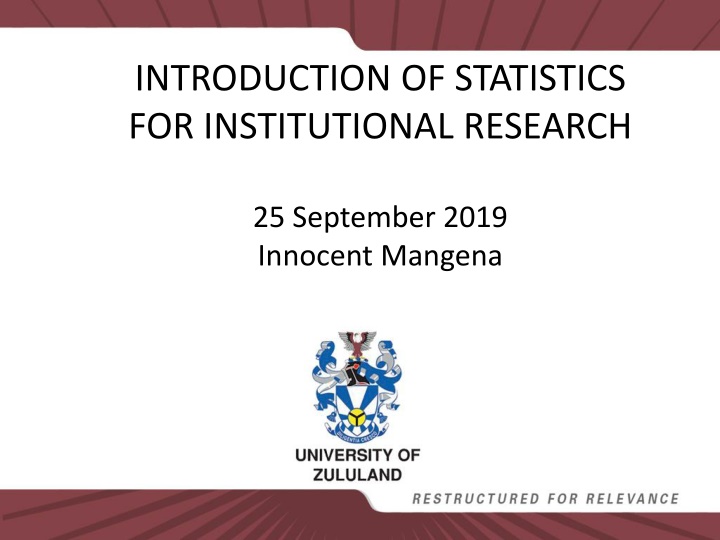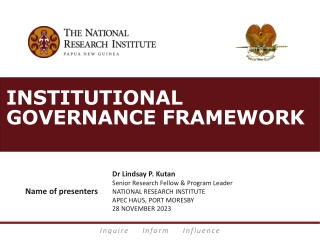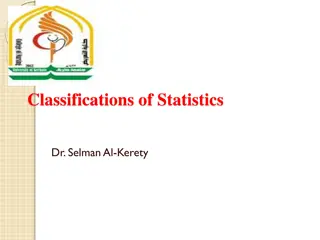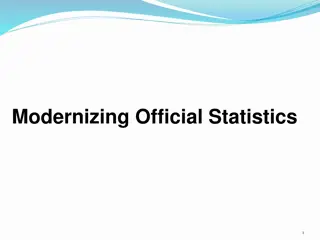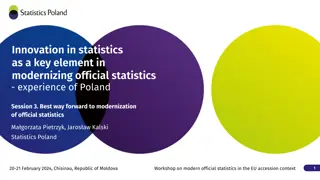Introduction of Statistics for Institutional Research
Delve into the role of statistics in Institutional Research through an exploration of data sources, analysis, and the crucial role played by institutional researchers. Understand how statistics inform decision-making, measure progress, and create new knowledge in academic settings.
Download Presentation

Please find below an Image/Link to download the presentation.
The content on the website is provided AS IS for your information and personal use only. It may not be sold, licensed, or shared on other websites without obtaining consent from the author.If you encounter any issues during the download, it is possible that the publisher has removed the file from their server.
You are allowed to download the files provided on this website for personal or commercial use, subject to the condition that they are used lawfully. All files are the property of their respective owners.
The content on the website is provided AS IS for your information and personal use only. It may not be sold, licensed, or shared on other websites without obtaining consent from the author.
E N D
Presentation Transcript
INTRODUCTION OF STATISTICS FOR INSTITUTIONAL RESEARCH 25 September 2019 Innocent Mangena
Overview Provide a basic use and value of statistics Focus is on statistics Institutional Research (IR) A basic understanding of numbers is assumed
Contents What is statistics used for? What is the role of statistics in IR? Focus on data: Data sources in institutional research Data analysis Concluding remarks
What is statistics used for? To inform and provide knowledge To measure and show progress To support decision-making through evidence Statistics facilitates the creation of new knowledge (Frost J, 2018)
Role of statistics in IR Institutional researchers have a critical role to play in the provision of appropriate information. Institutional information is meant to support decision-making and planning.
Where do we begin? Defining the research question Choosing the relevant research design Choosing the correct measurement Designing the questionnaire Sampling. i.e. choosing a representative sample from the population
How do we begin? Asking the right questions Symptoms Problem
How do we begin? Discovery 1 Insights 2 Actions 3 Outcomes 4
Data Sources in IR Internal Data Student data Staff data Asset data Financial data Procurement data External Data Survey data
Questionnaire design Consider how you intend to use the information know what statistics you intend to use Provide different question formats. i.e. open and closed-ended questions
Questionnaire testing Validity: The extend to which a concept or measurement is likely to accurately measure what is intended Reliability: The extend to which a data collection technique, a questionnaire for example, is likely to yield consistent results
Sampling Sampling provides a way of obtaining a representative view of the population, without studying the entire population. Friendship is a totally biased sample of the population, we only pick out the best ones. (Victor Bello Accioly, GoodReads)
Sampling [Cont.] Random sampling Sampling technique where each sample has an equal chance of being chosen Systematic sampling Sampling technique of choosing a random sample from a larger population Stratified sampling Sampling technique involving sampling from a population which can be partitioned into sub- populations or groups called strata
Data analysis Descriptive statistics: Description of data by means of tables and figures Description of of data by means of descriptive measures. i.e. Mean, Median, Mode, and etc. Inferential statistics: Use of sample data and descriptive measures to draw conclusions and make inferences or predictions about population
Descriptive statistics Values Frequency Cumulative Frequency 1 8 2 27 3 6 4 11 5 9 6 4 7 5 Percent 11% 39% 9% 16% 13% 6% 7% 8 35 41 52 61 65 70 Total 70 100%
Descriptive statistics [Cont.] Sharon 1.3, Amanda 1.8, Sindi 1.3, John 1.2, Shawn 1.7, Andy 1.5, Rose 1.6, Anne 1.4 Ordered sample: 1.2, 1.3, 1.3, 1.4, 1.5, 1.6, 1.7, 1.8 Mean = (1.2 + 1.3 + 1.3 + + 1.8) 8 = 11.8 Median = (1.4 + 1.5) 2 = 2.9 Mode = 1.3
Concluding remarks Statistics is important and is useful in IR Research questions must clearly be defined and research design chosen Data preparation should precede data analysis What if we draw the wrong conclusions from our analysis?
